Let me tell you a funny story. I was that person who always said "No way!" when someone offered me chicken feet. The thought of munching on what used to walk around in the farmyard? Not exactly what I dreamed of putting on my dinner plate. But here's the thing: Adobong Paa ng Manok completely changed my mind, and I bet it'll change yours, too.
Once you get past the "what am I eating?" moment, you'll discover this incredibly tender, flavor-packed dish that's literally swimming in a sauce so good you'll want to pour it over everything. The feet turn super tender after cooking with a texture that's surprisingly addictive - kind of like really soft, flavorful meat jelly (okay, that sounds weird, but in a good way).
Stop looking at them as feet. Instead, think of them as little flavor sponges that soak up all that garlicky, tangy adobo goodness. Your Filipino friends will be seriously impressed when you tell them you not only tried, but actually made Adobong Paa ng Manok from scratch.
Jump to:
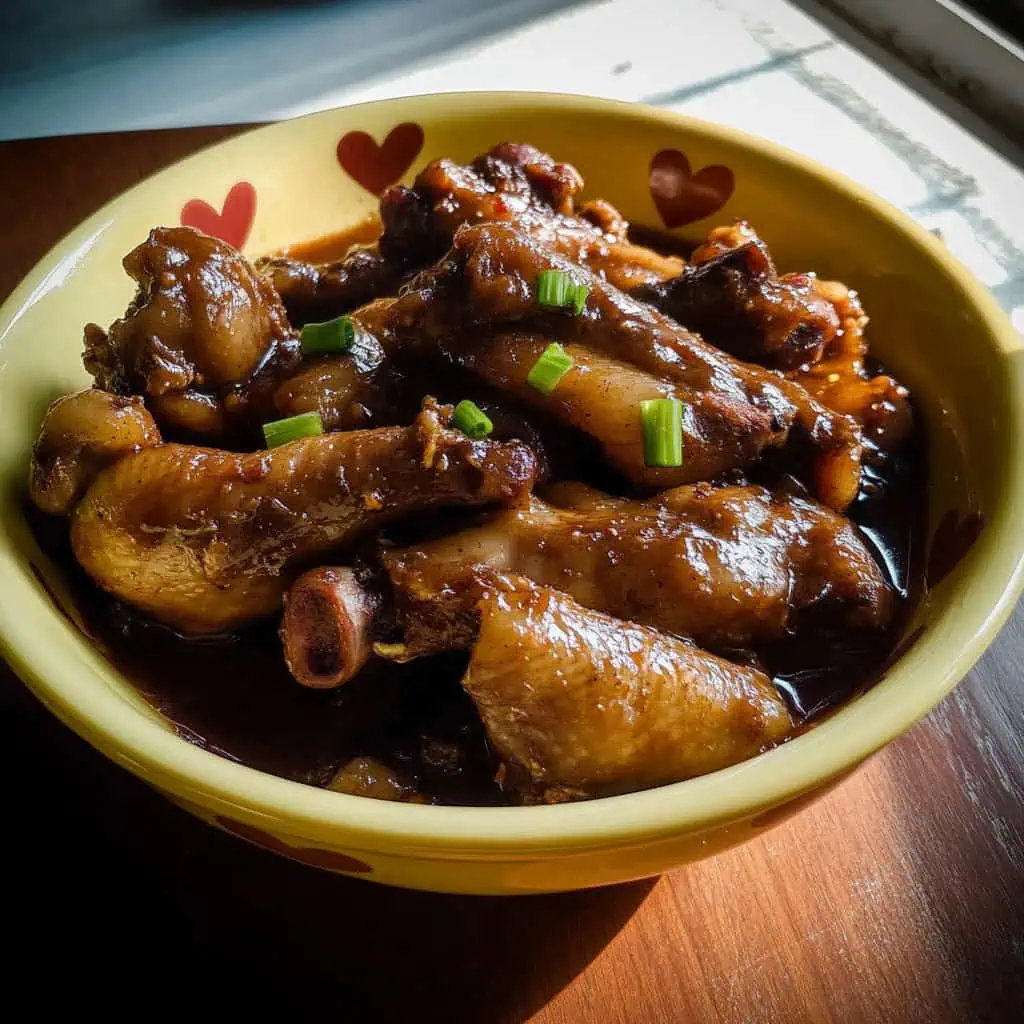
Why You'll Love This Recipe
- Rich in Collagen: The slow-cooking process releases healthy collagen from the chicken feet
- Complex Flavors: The perfect balance of sour, salty, and umami flavors
- Budget-Friendly: Transforms an affordable cut into a gourmet dish
- Authentic Taste: A true Filipino comfort food that brings back memories of home
- Perfect Texture: Tender meat that easily falls off the bone
- Versatile: Works great as pulutan (appetizer) or main dish
Ingredients
These ingredients create the perfect Filipino adobo flavor profile. Vinegar and soy sauce form the tangy, savory base that defines adobo cooking. Garlic, onions, and peppercorns add aromatic depth, while bay leaves contribute earthy notes.
Ginger and green onions in the blanching process remove gaminess from the chicken feet. Thai chilies add gentle heat, and oyster sauce brings richness and umami that balances the acidity.
Each element plays a crucial role in transforming humble chicken feet into a delicious, complex dish.
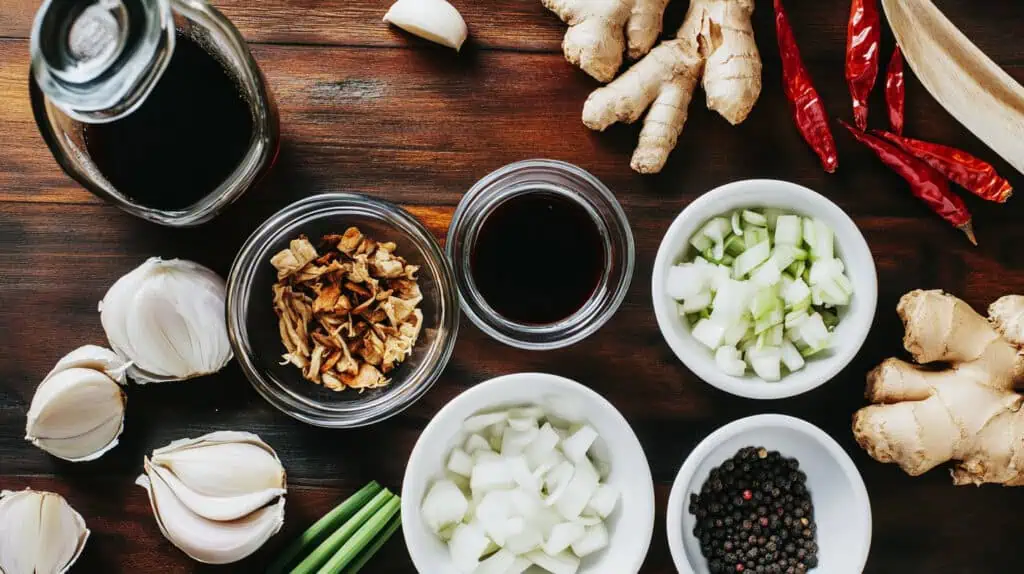
For Cleaning and Blanching:
- 3 pounds chicken feet
- 4 slices ginger
- 2 stalks green onions, knotted
- Rock salt for scrubbing
For the Adobo Sauce:
- ½ cup vinegar
- ¼ cup soy sauce
- 1 medium onion, peeled and chopped
- 1 head garlic, peeled and minced
- 2 bay leaves
- ½ teaspoon whole peppercorns, cracked
- 2 Thai chili peppers, minced
- 2 tablespoons oyster sauce
- Salt to taste
- Cooking oil for frying
Equipment
- Large pot: For blanching the chicken feet properly, ensuring thorough cleaning and removing impurities
- Deep frying pan or kawali: Essential for achieving that perfect golden brown exterior that adds flavor and texture
- Sharp knife or kitchen shears: For precisely trimming nails and calluses from the chicken feet
- Tongs: Allows for safe handling of hot chicken feet during the cooking process
- Strainer: For effectively draining the blanched chicken feet without losing any pieces
- Heavy-bottom braising pan: Provides even heat distribution during the long braising process for perfect tenderness
- Measuring cups and spoons: Ensures precise ingredient proportions for balanced flavors
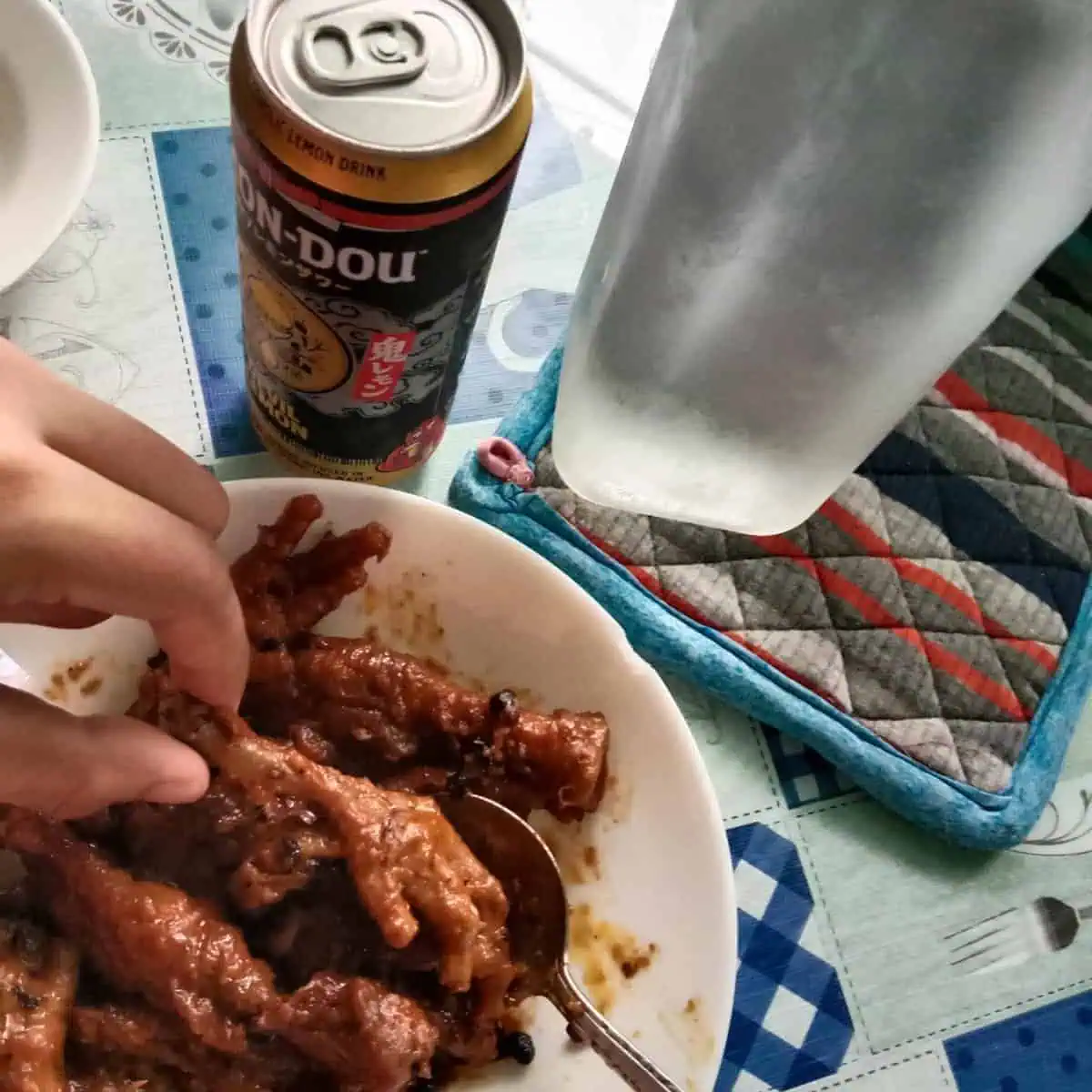
How To Make
- Start by cleaning your chicken feet. Using a sharp knife or kitchen shears, trim off the nails and any dark, callused areas. Scrub the feet thoroughly with rock salt, then rinse well with cold water.
- Fill a large pot with water and add your cleaned chicken feet along with ginger slices and knotted green onion stalks. Bring to a boil and cook for 7-10 minutes, occasionally removing any scum that rises to the surface. Drain the feet and pat them completely dry with paper towels.
- Heat cooking oil in a deep pot until it reaches 350°F (180°C). Carefully add the dried chicken feet and fry them for 3-4 minutes until they turn light golden brown. Remove from oil and immediately plunge them into a bowl of ice-cold water. Let them soak for one hour until the skin becomes wrinkled. Drain well.
- In a clean, large pan, heat one tablespoon of oil over medium heat. Add your chopped onions and minced garlic, cooking until they become soft and fragrant. Add the chicken feet to the pan.
- Pour in the vinegar, soy sauce, and one cup of water. Add your peppercorns, bay leaves, and chili peppers. Let it boil without stirring for 2-3 minutes. This step is important - don't stir yet!
- Lower the heat, cover the pan, and let it simmer for 50-60 minutes. Check occasionally, and if the sauce is drying out before the feet are tender, add water in half-cup portions as needed. You'll know they're done when the meat easily comes off the bone.
- Add the oyster sauce and salt to taste. Stir everything together and cook for a final 1-2 minutes. Your Adobong Paa ng Manok is now ready to serve hot with steaming rice.
Remember: The sauce will naturally thicken and become jelly-like when it cools - this is normal and comes from the natural collagen in the chicken feet. When reheating leftovers, simply add a splash of water and warm slowly over medium-low heat.

Tips from Lola's Kitchen
- Deep clean first: Scrub feet with calamansi before using salt for extra cleaning power and to remove any unwanted odors
- The ice bath is crucial: Don't skip the ice water soak - it creates that signature puffy texture that allows the feet to better absorb the flavors
- Hands off the vinegar: Let the vinegar boil untouched for the first few minutes to prevent it from becoming too acidic and harsh
- Save the liquid gold: Store the braising liquid for your next adobo - it's packed with flavor and gets better with each use
- Add eggs for extra protein: Whole hard-boiled eggs added during the last 10 minutes of cooking soak up flavors beautifully
- Patience is key: Don't rush the braising process; the longer and slower the cook, the more tender the feet will become
- Toast your garlic: For an extra layer of flavor, reserve some of the minced garlic and fry it until golden for a crispy topping
Substitutions
- Vinegar: White distilled vinegar can be replaced with apple cider vinegar for a milder tang or coconut vinegar for authentic Filipino flavor
- Soy Sauce: If watching sodium, use liquid aminos or coconut aminos which provide similar umami with less salt
- Thai Chilies: Substitute with 1 teaspoon of chili garlic sauce or mild banana peppers if you prefer less heat
- Oyster Sauce: Hoisin sauce or mushroom sauce can provide similar richness if oyster sauce isn't available
- Bay Leaves: In a pinch, dried basil or oregano can work, though the flavor profile will change slightly
- Chicken Feet: If you're not ready for feet yet, this adobo sauce works beautifully with chicken wings or drumsticks
Troubleshooting
- Feet still tough after cooking: Extend cooking time by 15-20 minutes, adding water as needed to maintain sauce level
- Too salty: Add 1-2 quartered potatoes during cooking to absorb excess salt, then remove before serving
- Too sour: Balance acidity with a pinch of brown sugar or an extra tablespoon of oyster sauce
- Feet not golden after frying: Ensure your oil is hot enough (350°F) before adding feet, and don't overcrowd the pan
- Sauce too thin: Remove lid during final 10 minutes of cooking to reduce and thicken the sauce
- Feet not absorbing flavor: Score the meatier parts slightly before cooking to allow sauce to penetrate
Storage & Reheating
- Refrigeration: Store in an airtight container for up to 3 days for best flavor and texture
- Normal gelatin: The sauce will gel when cold due to the natural collagen - this is completely normal and desired
- Gentle reheating: Always reheat on stovetop over medium-low heat, never use high heat which can toughen the meat
- Moisture addition: Add 2-3 tablespoons of water when reheating to restore the sauce's consistency
- Not freezer-friendly: Freezing affects the delicate texture of the chicken feet, so enjoy while fresh
- Better with age: Like many Filipino dishes, flavors develop and improve overnight in the refrigerator
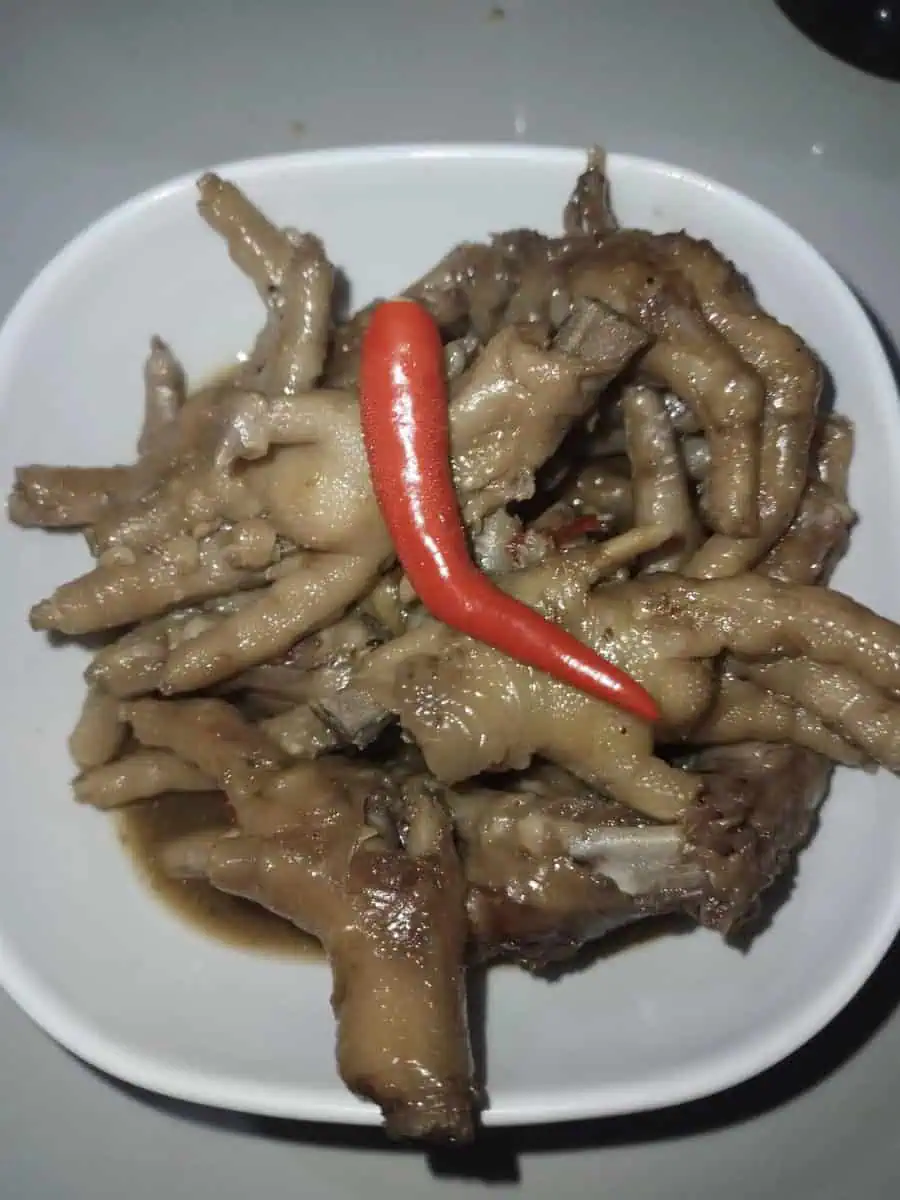
FAQ
Why do we need to deep fry the feet?
Deep frying serves multiple purposes - it creates a puffy texture that better absorbs the sauce, adds depth of flavor through Maillard reaction, and helps render some of the fat for a cleaner final dish.
Can I skip the blanching step?
No, blanching is crucial for cleaning and removing impurities from the chicken feet. It also helps remove any remaining feathers and makes the feet more tender.
How do I know when the feet are done?
The meat should easily come off the bone when gently pulled with a fork or your teeth. The texture should be tender but not falling apart completely.
Can I make this in advance for a party?
Yes, this dish actually tastes better the next day as flavors develop and meld together. Just reheat gently before serving.
Is this dish healthy?
Yes, it's rich in collagen and protein which benefits skin, hair, and joint health. However, it is high in sodium, so moderation is key if you're watching salt intake.
How do I eat chicken feet properly?
Hold the foot by the bony end, then use your teeth to gently pull the meat off. Don't try to eat the small bones - just enjoy the tender meat and skin.
Can I use a pressure cooker to speed up cooking?
Yes, after frying and the ice bath, you can pressure cook for 15-20 minutes instead of simmering for an hour, but the traditional slow-cook method develops deeper flavors.
What's the best rice to serve with this dish?
Freshly cooked jasmine rice is ideal as its subtle fragrance complements the bold flavors of the adobo without competing.
Related
Looking for other recipes like this? Try these:
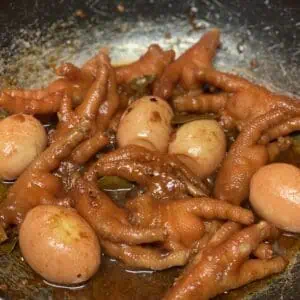
Adobong Paa ng Manok (Filipino Chicken Feet Adobo)
Equipment
- Large pot (kaldero) for blanching ensures proper cleaning of the feet
- Deep frying pan or kawali for achieving the perfect golden brown exterior
- Sharp knife or kitchen shears for trimming nails and calluses
- Tongs [Sipit] for safe handling of hot chicken feet
- Strainer [Salaan] for draining blanched chicken feet
- Heavy-bottom braising pan for even heat distribution during braising
- Measuring cups and spoons (Panukat) for precise ingredient portions
Ingredients
For Cleaning and Blanching
- 3 pounds chicken feet paa ng manok
- 4 slices ginger luya
- 2 stalks green onions dahon ng sibuyas, knotted
- Rock salt asin for scrubbing
For the Adobo Sauce
- ½ cup vinegar suka
- ¼ cup soy sauce toyo
- 1 medium onion sibuyas, peeled and chopped
- 1 head garlic bawang, peeled and minced
- 2 bay leaves dahon ng laurel
- ½ teaspoon whole peppercorns paminta, cracked
- 2 Thai chili peppers siling pangsigang, minced
- 2 tablespoons oyster sauce
- Salt asin to taste
- Cooking oil for frying mantika
Instructions
- Start by cleaning your chicken feet. Using a sharp knife or kitchen shears, trim off the nails and any dark, callused areas. Scrub the feet thoroughly with rock salt, then rinse well with cold water.
- Fill a large pot with water and add your cleaned chicken feet along with ginger slices and knotted green onion stalks. Bring to a boil and cook for 7-10 minutes, occasionally removing any scum that rises to the surface. Drain the feet and pat them completely dry with paper towels.
- Heat cooking oil in a deep pot until it reaches 350°F (180°C). Carefully add the dried chicken feet and fry them for 3-4 minutes until they turn light golden brown. Remove from oil and immediately plunge them into a bowl of ice-cold water. Let them soak for one hour until the skin becomes wrinkled. Drain well.
- In a clean, large pan, heat one tablespoon of oil over medium heat. Add your chopped onions and minced garlic, cooking until they become soft and fragrant. Add the chicken feet to the pan.
- Pour in the vinegar, soy sauce, and one cup of water. Add your peppercorns, bay leaves, and chili peppers. Let it boil without stirring for 2-3 minutes. This step is important - don't stir yet!
- Lower the heat, cover the pan, and let it simmer for 50-60 minutes. Check occasionally, and if the sauce is drying out before the feet are tender, add water in half-cup portions as needed. You'll know they're done when the meat easily comes off the bone.
- Add the oyster sauce and salt to taste. Stir everything together and cook for a final 1-2 minutes. Your Adobong Paa ng Manok is now ready to serve hot with steaming rice.
- Remember: The sauce will naturally thicken and become jelly-like when it cools - this is normal and comes from the natural collagen in the chicken feet. When reheating leftovers, simply add a splash of water and warm slowly over medium-low heat.
Tips from Lola's Kitchen
- Scrub feet with calamansi before salt for extra cleaning power
- Don't skip the ice water soak - it creates that signature puffy texture
- Let the vinegar boil untouched to prevent it from becoming too acidic
- Save the braising liquid for your next adobo - it's liquid gold!
- Add whole hard-boiled eggs during the last 10 minutes of cooking
Nutrition
The Story Behind Adobong Paa ng Manok
Adobong Paa ng Manok, a beloved Filipino delicacy, tells a fascinating story of resourcefulness and culinary innovation in Philippine cuisine. This dish emerged from the traditional Filipino practice of utilizing every part of the chicken, a testament to our ancestors' wisdom in preventing food waste and maximizing available resources. In many Filipino households, especially in provincial areas, chicken feet were often overlooked by colonial masters, leaving local families to transform these humble ingredients into something extraordinary.
The preparation of chicken feet in Filipino cooking dates back generations, but the addition of the adobo cooking method - the signature vinegar-soy sauce combination - elevated this dish to new heights. Adobo, which comes from the Spanish word "adobar" meaning to marinate, was adapted by Filipinos long before the Spanish colonial period, originally using native vinegar and salt. The introduction of Chinese soy sauce during the pre-colonial trading era added another layer of complexity to the dish we know today.
In the bustling streets of Manila and other Philippine cities, Adobong Paa ng Manok gained popularity as affordable yet flavorful pulutan (bar food) in local carinderia (small eateries) and street-side establishments. The dish's reputation grew as diners discovered that the collagen-rich chicken feet, when properly prepared, offered an incredibly tender texture and the ability to absorb the rich adobo sauce perfectly.
Modern Filipino cuisine has embraced this dish as both a symbol of heritage cooking and a testament to sustainability in food preparation. Today, you'll find Adobong Paa ng Manok being served not only in humble neighborhood eateries but also in upscale Filipino restaurants, where chefs are giving this traditional dish contemporary twists while maintaining its authentic flavors. The dish has even gained international recognition, particularly in other Southeast Asian countries where chicken feet dishes are also celebrated.
What makes this dish truly special is its ability to bring people together. In Filipino culture, eating Adobong Paa ng Manok is often a communal experience, where friends and family gather around the table, using their hands to carefully navigate the tender meat off the small bones - a practice that naturally encourages conversation and bonding. This social aspect has helped cement its place in Filipino culinary tradition.
The preparation method itself has evolved over time, with different regions adding their own local touches. Some versions incorporate coconut milk for added richness, while others increase the heat with local chilies. In the Visayas region, some cooks add a touch of lemongrass, while in Bicol, the dish might feature the region's famous siling labuyo (bird's eye chili) for an extra kick. Despite these variations, the core technique of braising the feet in vinegar and soy sauce remains constant, creating that distinctive adobo flavor that Filipinos know and love.
For many overseas Filipinos, Adobong Paa ng Manok serves as a powerful reminder of home, carrying with it memories of family gatherings and late-night meals with friends. It represents the Filipino talent for turning humble ingredients into dishes worthy of celebration, showcasing our culture's deep respect for food and community. Whether enjoyed as pulutan with ice-cold beer or served as a main dish with steaming white rice, this dish continues to tell the story of Filipino culinary heritage, one chicken foot at a time.
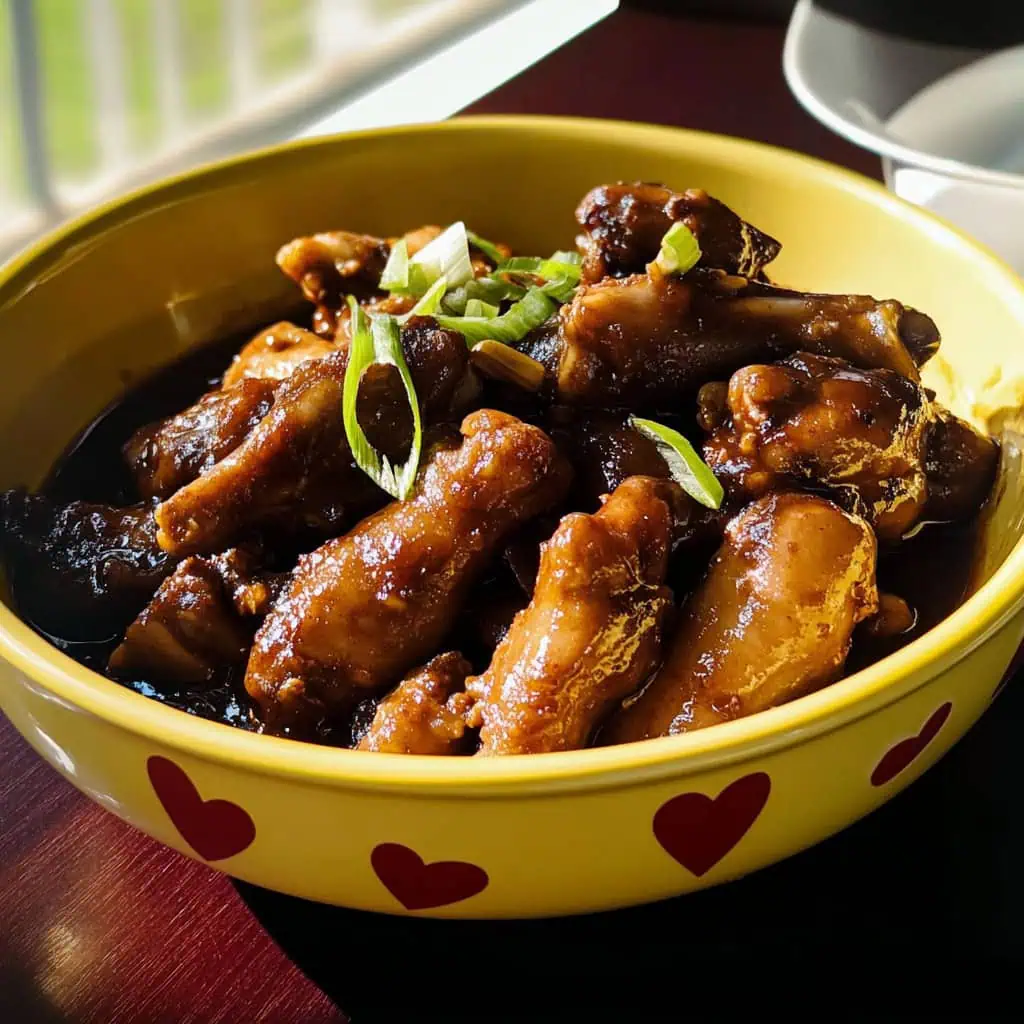








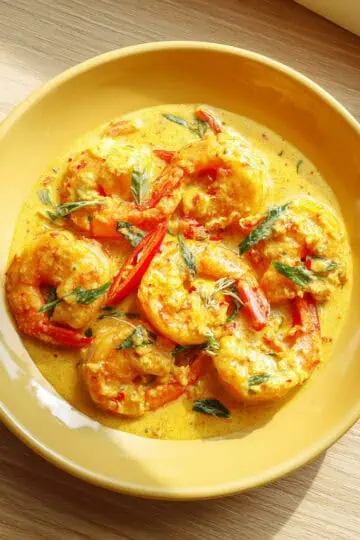
Comments
No Comments